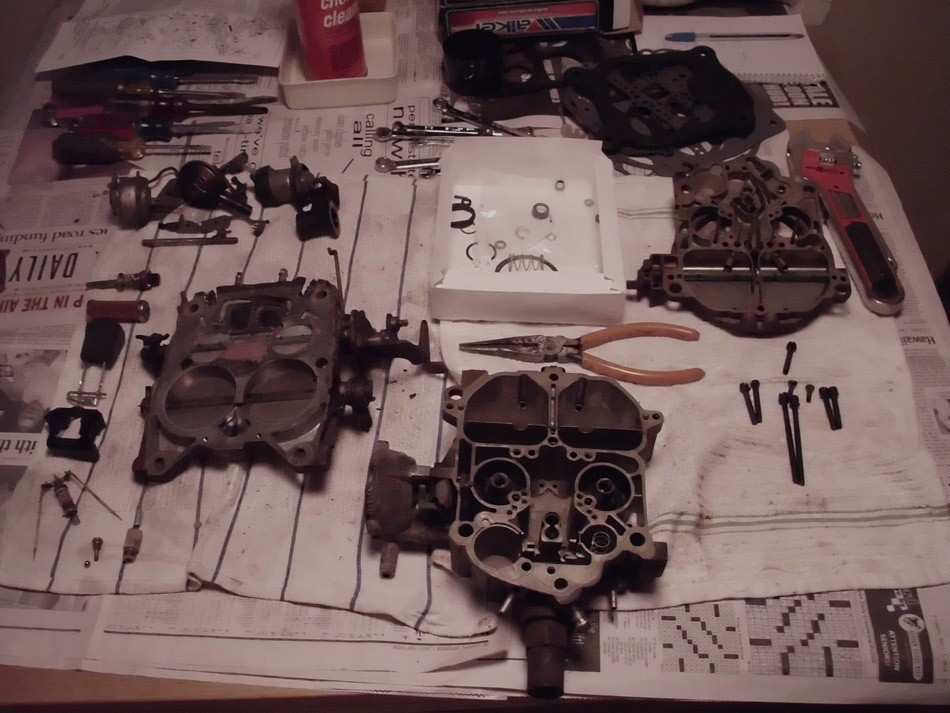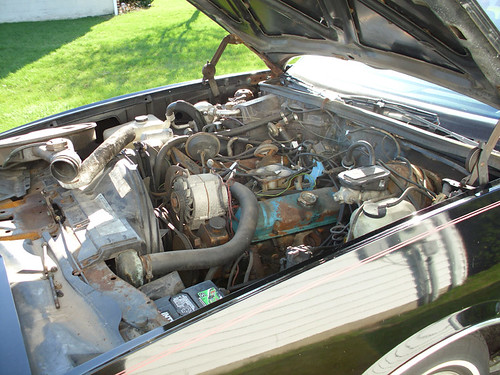About a month ago, that big ol' boat of a Pontiac I have started running poorly, it would barely idle, and had very little power when you gave it gas.

When a car of that age starts behaving that way, with little warning, it's usually the fault of the Carburetor
Without getting too complex, car engines run on gasoline, but gas itself doesn’t burn very efficiently in liquid form. So, every gasoline engine has a device on it with a function to turn liquid gas into a mist-like vapor, and then mix it with air (in a roughly 7:1 gas to air ratio) which it then fed into the cylinders and is what actually burns to make the engine run.
Just about every car and truck built from about 1985 to today now use fuel injection, where a tiny computer-controlled nozzle squirts a bit of fuel into the passing airstream. But in the bad ol’ days, before computers could do that precisely, every engine had one of these on it. A carburetor, which does the same thing, in a painfully convoluted way. See, instead of a computer, the “program” is that the carb has a set of internal baffles, and valves and one-way passages that open or close based on how much work the engine is doing. (On a modern fuel injected car, the computer just monitors the speed and throttle and adjusts itself on the fly accordingly) As your engine works harder and harder various chambers inside this thing build up vaccum or pressure, and then open or close to change the fuel/air mix. Everyone, including car guys, HATE working on carbs because they’re a bit on the complex side. And from 1966 to 1981, every Pontiac used one of these, a Rochester Quadra-Jet Carb. Named after Rochester, New York, where the carb factory for all the GM cars was.
Looks like a plumbers nightmare already doesn’t it?

Well, it comes apart in 3 major layers, like a wedding cake, and you can see the complexity, each one of those holes in each layer is a passage that something has to flow through, in the right amount, for it all to work.
Rather than troubleshoot these when they go bad, it’s easier just to buy a rebuild kit (as you can see, that’s what I did) that includes new internal gaskets and valves, and just replace them all. Though if I had to put some money down, I’d wager that the fuel filter (that thing on the middle left side that looks like a shotgun shell) is the culprit.

After Easter, I’ll put it back on the motor and see if my hunch was right. (and yes, Pontiac used to paint their engines blue)


When a car of that age starts behaving that way, with little warning, it's usually the fault of the Carburetor
Without getting too complex, car engines run on gasoline, but gas itself doesn’t burn very efficiently in liquid form. So, every gasoline engine has a device on it with a function to turn liquid gas into a mist-like vapor, and then mix it with air (in a roughly 7:1 gas to air ratio) which it then fed into the cylinders and is what actually burns to make the engine run.
Just about every car and truck built from about 1985 to today now use fuel injection, where a tiny computer-controlled nozzle squirts a bit of fuel into the passing airstream. But in the bad ol’ days, before computers could do that precisely, every engine had one of these on it. A carburetor, which does the same thing, in a painfully convoluted way. See, instead of a computer, the “program” is that the carb has a set of internal baffles, and valves and one-way passages that open or close based on how much work the engine is doing. (On a modern fuel injected car, the computer just monitors the speed and throttle and adjusts itself on the fly accordingly) As your engine works harder and harder various chambers inside this thing build up vaccum or pressure, and then open or close to change the fuel/air mix. Everyone, including car guys, HATE working on carbs because they’re a bit on the complex side. And from 1966 to 1981, every Pontiac used one of these, a Rochester Quadra-Jet Carb. Named after Rochester, New York, where the carb factory for all the GM cars was.
Looks like a plumbers nightmare already doesn’t it?

Well, it comes apart in 3 major layers, like a wedding cake, and you can see the complexity, each one of those holes in each layer is a passage that something has to flow through, in the right amount, for it all to work.
Rather than troubleshoot these when they go bad, it’s easier just to buy a rebuild kit (as you can see, that’s what I did) that includes new internal gaskets and valves, and just replace them all. Though if I had to put some money down, I’d wager that the fuel filter (that thing on the middle left side that looks like a shotgun shell) is the culprit.

After Easter, I’ll put it back on the motor and see if my hunch was right. (and yes, Pontiac used to paint their engines blue)






 for the bearings
for the bearings
Comment